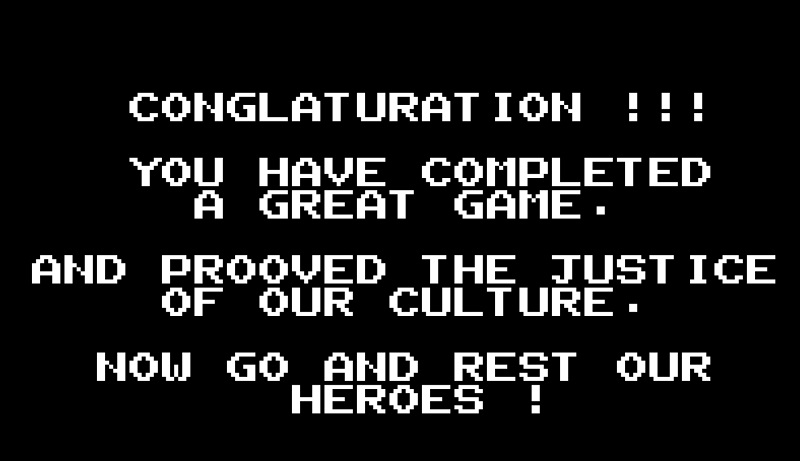Can a video game evoke real emotions? Can it, for example, make you feel like you are in the scene in Ghostbusters where four out of shape, middle-aged men are forced to walk up 22 flights of stairs? Ghostbusters is a decent game until it answers that question.
Part 1: C64 and NES Ghostbusters
Ghostbusters: The Computer Game
C64 - David Crane, 1984
Although Ernie Hudson's kids said it sucked, Ghostbusters was reviewed well at the time. It was designed by David Crane, a famous games designer of the 80s and co-founder of Activision. Crane's work includes Pitfall! and Little Computer People, a spiritual ancestor of The Sims.He clearly designed Ghostbusters to align with the film in story and gameplay as much as could be done at the time, which is great. The music is the best of the bunch despite being the oldest console. The classic theme tune gets chilled out and slowed down a bit, which helps your sanity across a long gaming session.
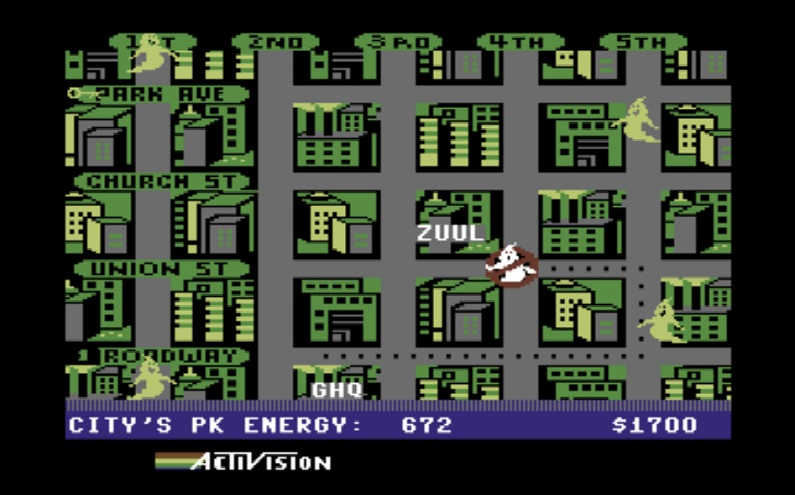
Before you get bustin’, you must first enter your name in a business registration screen, something all the 80s kids were dying to do. A wall of text explains that as in the film, you have taken out a bank loan and need to earn money to pay it off by busting ghosts. You get to choose which car you would like to buy, as if anyone is not choosing the Ecto-1, then you’re dropped into the city map and the game begins.
To summarise, you drive to haunted city blocks and then bust ghosts there, both of which are little minigames. The money you earn from busting ghosts is put towards paying for your gas, but among other upgrades you can also improve the range of your proton stream and number of ghosts you can trap without driving back to HQ again, which is very handy.
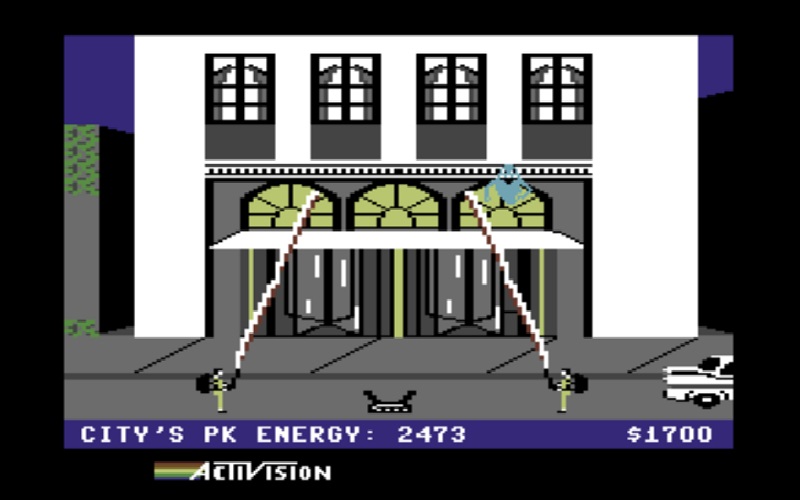
When the psychokinetic energy of the city builds up to a certain point, the central building will unlock and you can fight the final boss. It’s a short boss fight which is not too hard, a bit too simple, if anything.
This cannot be said of the NES version.
Ghostbusters
NES - Bits Laboratory, 1986
No time for any business loan applications for Nintendo, you’re dropped straight into the city screen, with the Ecto-1. Generally I enjoy more complicated games but in this case the business side of the C64 version really wasn’t worth the effort and didn’t really pay off (no pun intended). I preferred the immediacy of the NES version, in which you drive to the shop to upgrade instead.
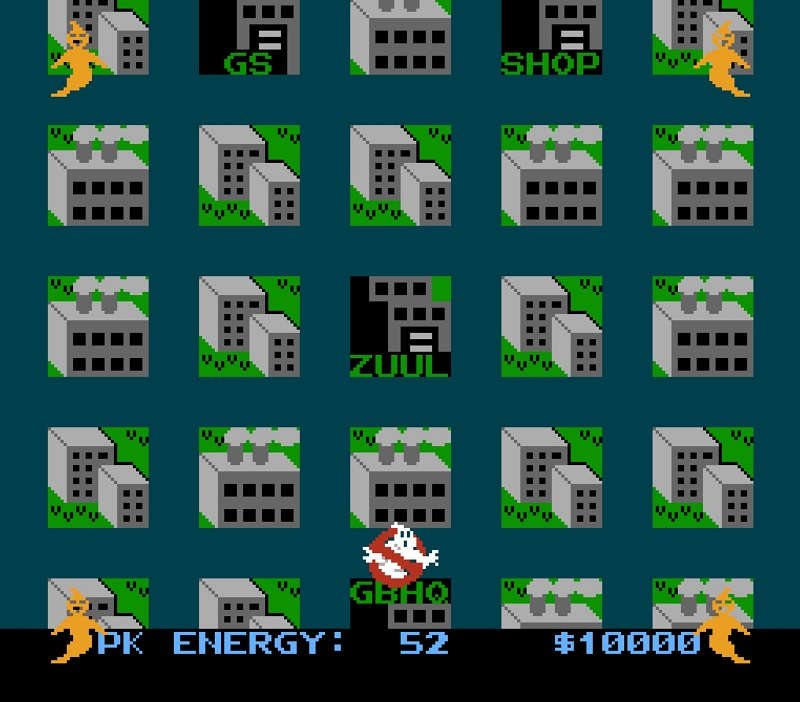
The driving minigame in all three versions gets tired quickly. You avoid obstacles and collect items while the screen scrolls vertically, and it can feel like it goes on forever. The distance for each drive is based on the route you took on the map screen, including any backtracking, and on the C64 and Master System versions this is shown on the screen, making it a bit more intuitive. The NES version doesn’t show the map route but instead tells you the distance to the end of the driving section, which is of more help to the player.
On the C64 you mainly catch ghosts while driving, but on the NES there’s more to do. You mostly avoid traffic, but there are still some ghosts and fuel barrels to collect as well. The catch-22 is that if you go slow enough to catch ghosts and collect fuel barrels, you’ll run out of fuel within a couple of runs. Not to mention it will take longer, which is something you very much don’t want.
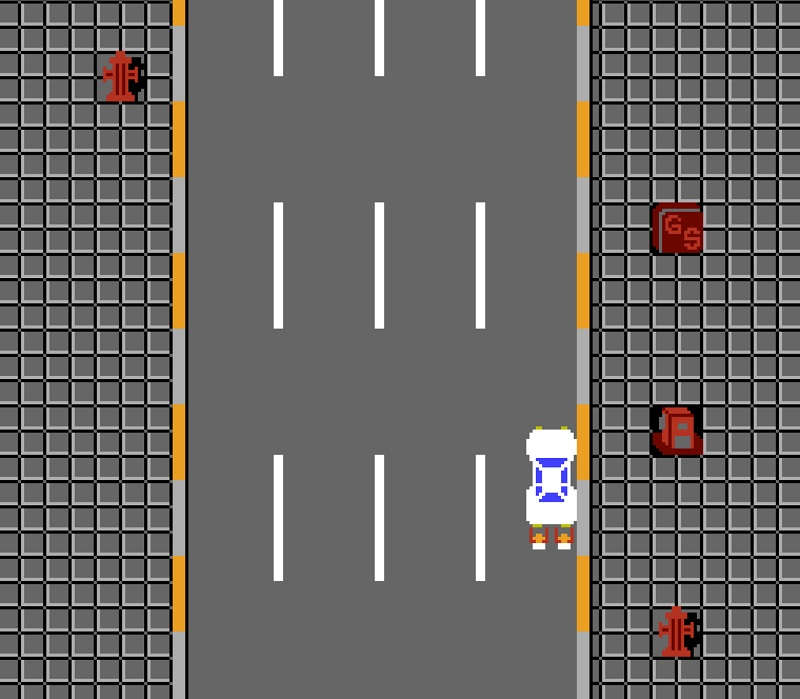
If you go to bust ghosts: driving section. You must then return to HQ to empty your trap: driving section. After a few of these you’ll need to go to the gas station, you guessed it: driving section. This makes driving the main activity you’ll be doing throughout the game, although you would think it would be bustin’.
They’ve made an effort to make ghost busting mechanically similar to the movies, which is great. You set your trap, activate your proton packs and then walk your Ghostbusters around, switching between them at will, hoping to snare a ghost. Ghosts move around the top of the screen, and wander down to the bottom half, where you can snare them with your streams.
In the C64 version you don't snare the ghosts, instead herding them towards the trap, which is a bit lame. You then have to walk back to the trap and activate it. When activated, the trap catches anything directly above it as well, so if you time it right you can get ghosts that aren’t even caught in your streams. There’s also a time limit, so there is some risk/reward trade off on getting them back to the trap in time. There’s enough going on that it’s quite fun.
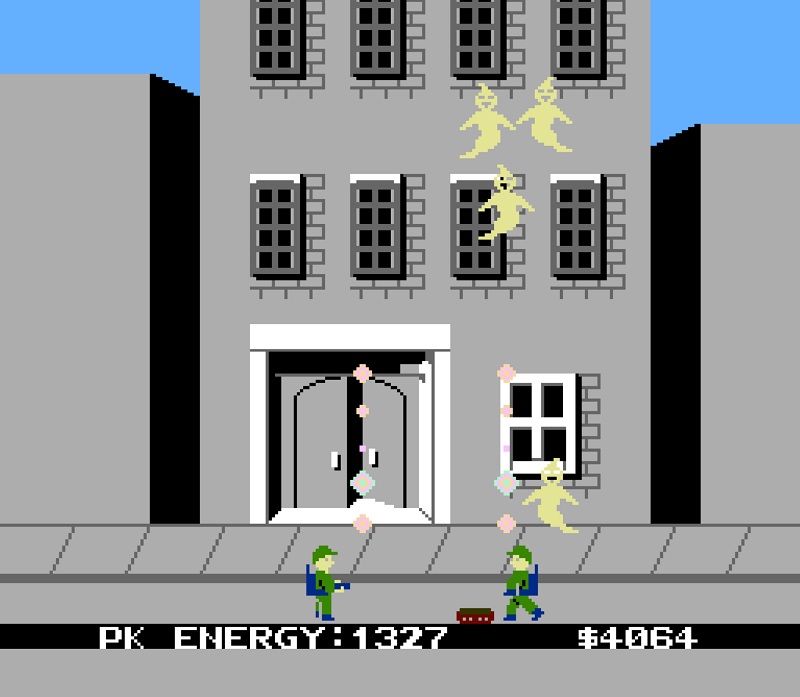
What’s less fun is when the ghosts spread out and decide never to come down to the bottom of the screen at all. The time limit isn’t shown, so the player just has to guess when to go back to the trap rather than use judgement, which is a shame. Combine these two faults and you sometimes get non-stop driving sections and another trip to the gas station.
But here’s where Bits Laboratory really deviated from the C64 version. Instead of unlocking the boss fight when the PK activity reaches a certain threshold, in the NES version it unlocks when you earn a certain amount of money. And instead of the simple boss of the C64 version, you get a proper boss fight. But first you must climb the staircase to get to them.
Oh, the staircase. You control three Ghostbusters which move as one, and you have to walk across the floor and up the stairs to the next level while avoiding ghosts. Simple! But in order to move, you must hold the direction button and press A. This will move you about five pixels in that direction. If you feel like moving another few pixels, press A again. You have to tap, tap, tap the button. Repeatedly. Non-stop. As fast as you can. For 22 floors. Twenty. Two. Floors. Of. This.
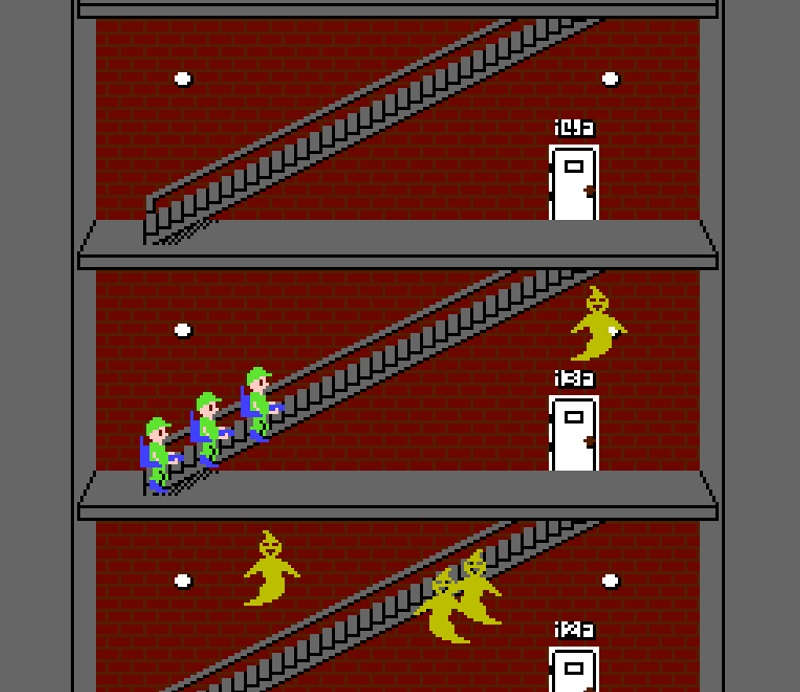
It’s impossible to overstate how slow and how bad this is. I cannot even imagine getting to this point as a child, I literally searched the internet to see if my version of the game was bugged. An absolutely astounding game design choice. My hand started cramping by the time I got to about the eighth floor after many attempts.
Here I had to cheat, turning on the turbo (auto-press) function on the controller, although making your character move at a normal game character speed hardly feels like cheating. While third-party controllers like the Joycard Sansui SSS from Hudson Soft (they of Bomberman fame) did exist in the 80s, it was a luxury most did not have. Worse, the ghosts are coded to the screen, not the background, so they move with you as you climb the levels. They move randomly around, and in some cases they are simply unavoidable no matter how fast you go.
Even with turbo it’s extremely difficult to reach the top, but if you can be bothered to get through it and defeat the boss you might agree it’s worth it. In general I avoid spoilers of stories or nice fun surprises, but if you don’t plan to play it, you owe it to yourself to view probably the best end-game screen I’ve ever seen.
There’s one more port of this game, that of the Sega Master System, which shows that, thank Gozer, not all staircases are created equally.
Part 2: The Sega Ghostbusters Games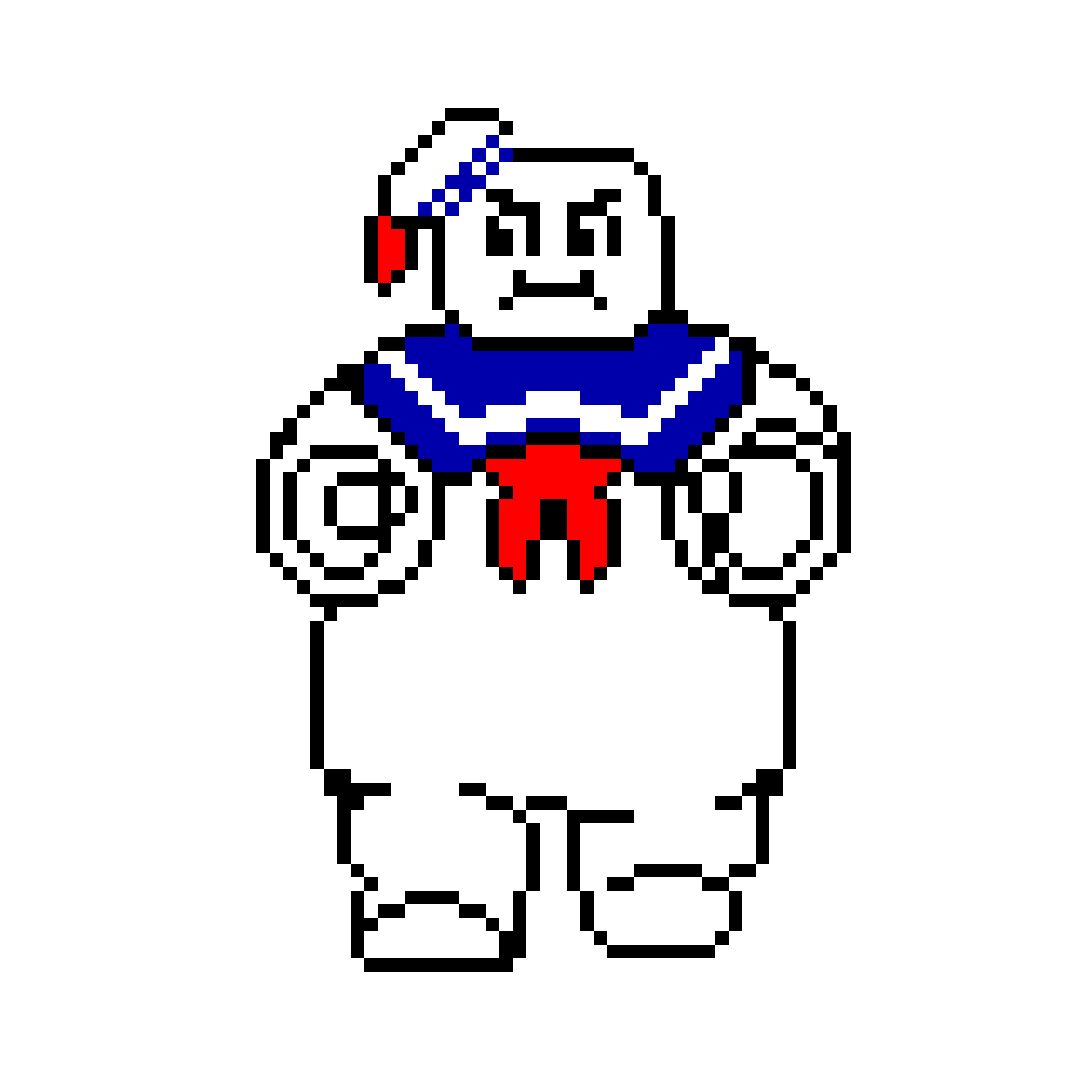
All game posts:
© P7uen 2023 | Base style css by EGGRAMEN 2020
